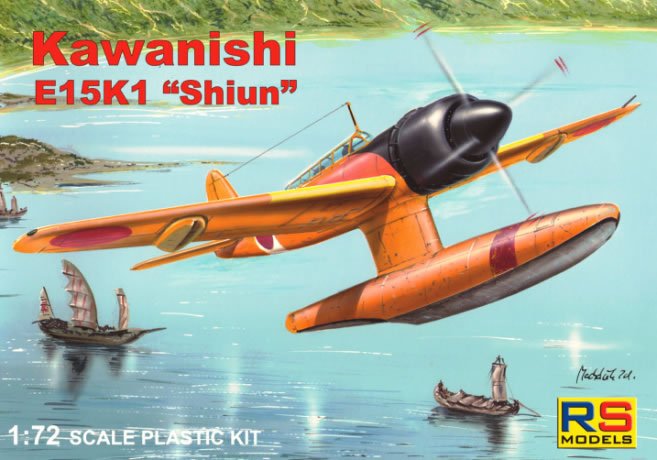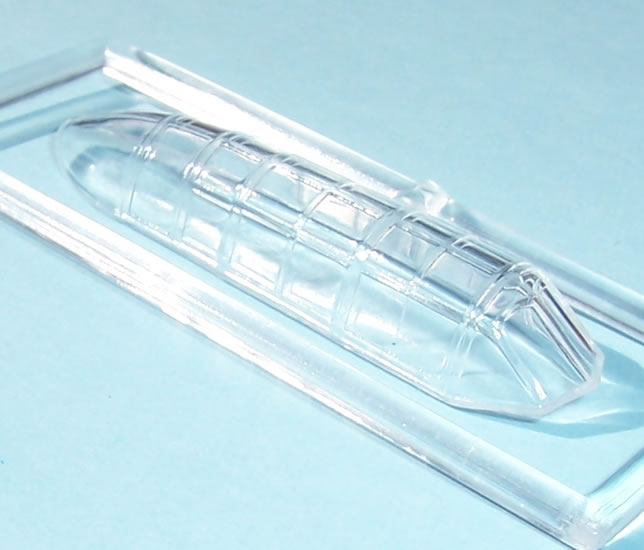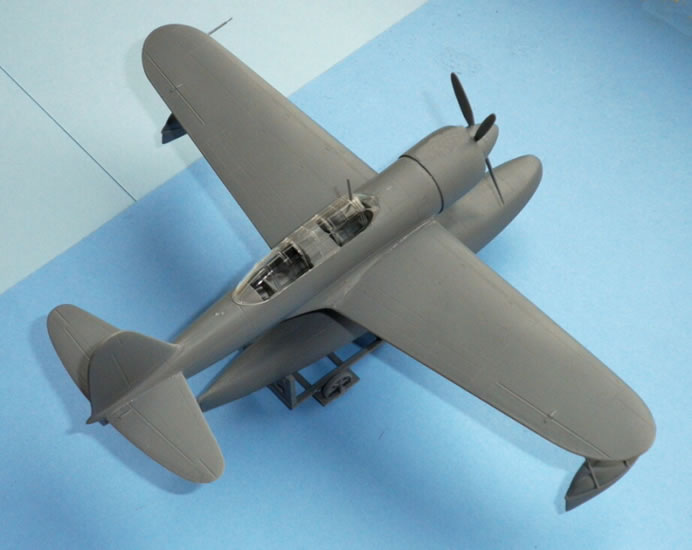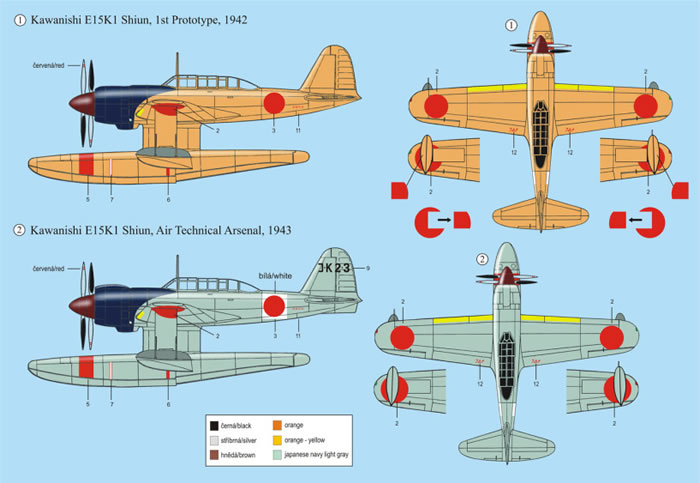|
Kawanishi E15K1 Shiun

RS Models, 1/72 scale
S u m m a r y : |
Catalogue Number: |
RS Models Kit No. 92075 - Kawanishi E15K1 Shiun |
Scale: |
1/72 |
Contents & Media |
38 x grey styrene airframe parts, 1 x clear styrene canopy and decals for two aircraft. |
Price: |
Available online from Hannants for £14.81, Squadron for US$30.55, and Modelimex for €17.50 (click here for currency conversion). |
Review Type: |
First Look |
Advantages: |
Fine surface detail, straightforward build, seat belts moulded with the seats. |
Disadvantages: |
A minor point, but red of the decals may be too light. |
Conclusions: |
A simple well executed limited run kit of a rare but attractive floatplane. Recommended. |
Reviewed by Mark Davies

Valom's 1/48 scale An-2 Colt is available online from Squadron.com
Background
In 1939 the Imperial Japanese Naval Air Force ordered a high-speed reconnaissance floatplane from Kawanishi. The specification called for the aircraft to be able to outrun enemy land based fighters, and left a lot of leeway as to how this difficult requirement was to be met.
Kawanishi settled on an innovative approach to keep the design as clean as possible by having the wing floats retract almost fully into the wing. This was achieved by making the upper parts of the floats from inflatable rubberised material, thus enabling them to be deflated and compressed when the float retracted. Only the metal planing bottoms of the floats protruded into the slipstream. The float bracing structure was fully skinned and formed the bottom surface of the wing when the floats were stowed. Added to this measure were a laminar flow wing, a powerful (for the time) 1,460-hp engine, and the ability to jettison the main central float if needed. A clean airframe and typically light Japanese structure also contributed to the design’s quest for speed.
Two contra-rotating props were used, a first for a Japanese aircraft. Whilst cancelling torque effects is an obvious advantage of such a system it also served to add complexity and caused reliability problems. Problems were also encountered with the retractable inflatable floats. The first flight did not take place until December 1941. Problems continued and in the end fixed outboard floats were adopted and a more powerful engine fitted to offset the additional drag incurred due to this change. This version was the E15K2.
Development problems continued and eventually just six prototypes and nine production aircraft were built. Further development was cancelled early in 1944. Six saw operational service in Palau, but contributed little to the declining situation faced by the Japanese. Despite all of the innovation their dash performance was well below that of both the ship-based and land-based fighters opposing them. In fact the aircraft’s performance was only marginally better than the A6M2-N floatplane version of the Zero.
Previous 1/72 E15K1 Kits
I’m aware of four previous 172-scale E15K1 kits, these being from:
-
Aoshima (re-boxed by UPC, BMW & Farpro) - A fairly basic1960’s Japanese injected kit with raised surface detail, movable ailerons and no cockpit detail other than two crew figures. Probably more for the collectors than builders amongst us. Old Aoshima re-releases were still being distributed in NZ (my home) only a year or two ago, and no doubt in other markets too.
-
Miyazawa - A basic early generation resin kit with some white metal parts. A nice model could result without too much effort. It would be a real rarity to find one now.
-
A+V Model - A resin kit about which I know nothing more.
-
Aviation USK/Xotic - A short run kit with PE details. Of very similar quality to early MPM kits (no surprise as I’m sure that MPM manufactured it for Aviation USK). I have read that the rear fuselage was a bit too slender in plan view, but with some work typical of such kits a very presentable model could result. I should think it’s now only available 2nd hand or from the odd dark corner of some hobby shops.
The kit comes in a typically Czech end-opening box with attractive artwork on the front. The instructions provide a parts map and easy to follow diagrammatic assembly format. There is also a brief history of the aircraft with English text. Painting and decal guides are quite adequate and printed in colour on the back of the box. Generic colour names are used for colour call-outs.
I have numerous RS kits and this one is quite typical of the brand. All parts are cleanly moulded with fine surface detail and narrow sprue gates. A little flash is visible in places, but will be easily dealt with. I did notice a slight fault or mould damage on the starboard rear chine of the centre float just aft of the step, but this looks to be easily repairable. Construction sequence and parts breakdown is conventional for the type.
Cockpit detail is sparse, although commendably the two seats have moulded lap belts. There is also an instrument panel, floor, control column and two bulkheads. The clear one-piece canopy is injected, bright and clear, and of acceptable thickness. With so many canopy frames the sparse interior will matter very little.

Airframe assembly looks to be very straightforward, and the instructions provide a handy head-on view to assist with float alignment. The outrigger floats are moulded for the down position only, which will probably suit most builders. A beaching trolley is provided that appears to be a direct copy of the one provided by Hasegawa with its N1K Kyufu kits. This is a nice addition and I know from my N1K1 models that the beaching trolley really adds to the appearance of the displayed floatplane model.

The images accompanying this article of a partially assembled and finished model are from RS Models’ web-site.

RS Models also offer a production machine with boxing #92076 whose box artwork accompanies this article.
Decals look to be well registered with good opacity, although I think that the red of the national insignia and float bands looks a little light to me.

Two options are included, these being:
-
The 1st prototype in 1942. Overall orange with a black cowl and an anti-glare panel that sweeps down to the oil cooler, plus the usual red warning and white beaching gear stripes on the main float.
-
An aircraft of the Air Technical Arsenal in 1943. Overall IJN light grey with a black cowl and an anti-glare panel that sweeps down to the oil cooler, and has red and white float stripes plus yellow wing leading edge identification bands and white backgrounds to the fuselage hinomaru.

As supplied the decals include full sets of both plain red and white outlined hinomaru, although the painting and decaling guides indicate that only the plain red ones are needed.
This is a simple but well executed limited run kit of a rare but attractive floatplane. Recommended.
Thanks to RS models for the review samples.
Thanks to RS Models for these review samples.
Review Text and Images Copyright © 2011 by Mark Davies
Page Created 29 August, 2010
Last updated
29 August, 2011
Back to HyperScale Main Page
Back to Reviews Page

|
